Many people think that roundabouts and traffic circles are the same thing when they drive through these circles. But, actually, they are not. So, you should be well aware of the functions and differences between traffic circles and roundabouts.
Therefore, in this article, you will learn all about roundabouts vs traffic circles, their rules, and how they work.
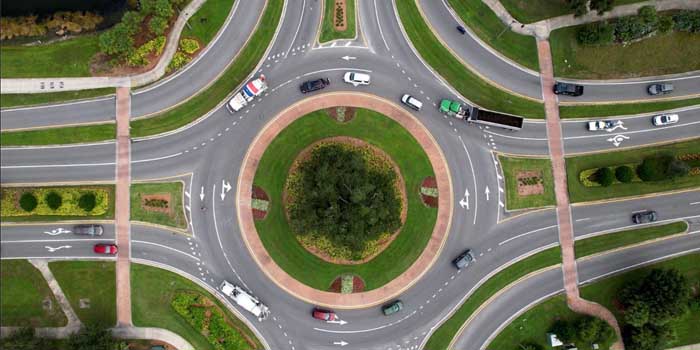
What are Roundabouts?
Roundabouts are small circular or curvy-shaped roads where you can drive your car around a center island. You must take a right turn and drive your vehicle in circular directions (counterclockwise) until you reach your exit point.
Always remember, when you enter this area, you have to stop and let other cars go which are already present inside the roundabout. You will see no traffic lights, so you need to follow signs & carfully observe other vehicles.
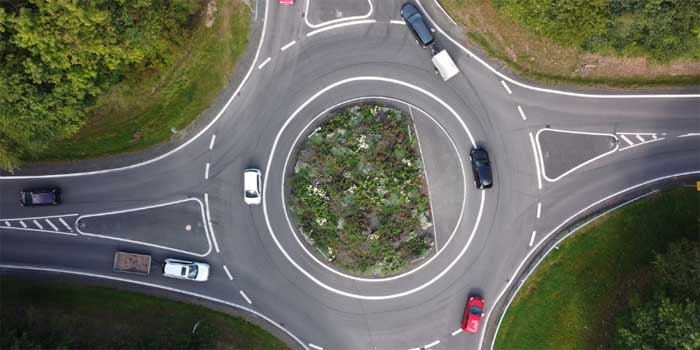
History and Evolution of Roundabouts
Who invented roundabouts? The history of roundabouts started over 100 years ago. In Europe, the first roundabout was made in 1907, so that cars can easily pass in busy traffic zones. This idea was first launched by a French planner named Eugène Hénard. However, the old traffic circle was totally different from what you see today.
At that time, builders constructed large roundabouts, and they also didn’t follow clear rules. It created a problem for many drivers as they did not know when to move & stop. This caused lots of crashes and dangerous situations. After all crises, engineers decided to design modern roundabouts in the 1960s. They made roundabouts which are small in size and also follow clear regulations.
For example: when you drive in a roundabout, you have to slow your car and allow other vehicles to pass first. This infrastructure and rules make the roundabout more safe for you as compared to old ones.
Today, you will see modern roundabouts are used in many countries such as the United States, the United Kingdom, Australia & France. Now, you will also find them without traffic lights because roundabouts help you to drive safer and faster with less chance of danger.
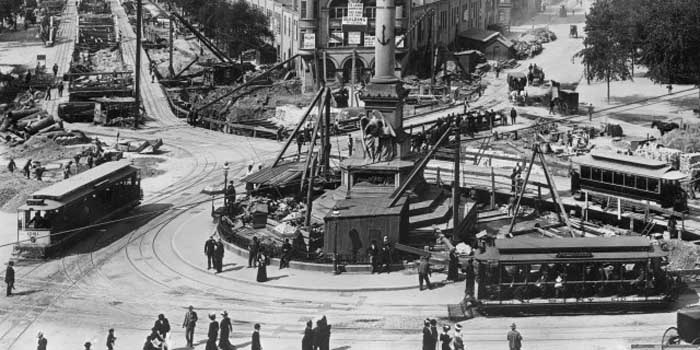
Difference Between Traffic Circle and Roundabout
| Main Points | Roundabout | Traffic Circle |
| Size | Small & has narrow bends | Wider lanes and larger in size |
| Traffic Flow | Maintain smooth flow and you no need to fully stop. | Unsteady traffic flow due to cars stopping inside the circle |
| Speed | Slow (15–25 mph or 24–40 km/h) | More fast (30+ mph or 48+ km/h) |
| Traffic Signs & Signals | You will see only yield signs but no traffic lights | Have stop signs & traffic lights too |
| Safety | It has many safety features: signs, markings & raised edges | You will have less safety feature with traffic circle |
| Location | Made in busy streets and updates city zones | Mostly, you find them in old-style or historic parts of cities |
| Yielding | You have to yield to other vehicles at any cost | Rules varies and you may not need to yield |
| Pedestrian Crossing | There are safe paths present for walker | Can be risky for people who walk (no-crosswalk) |
| Lane Changing | You no need to change lanes | You always need to switch lane while inside |
| Entry Angle | Smooth entry bends/angles | Dangerous & tight entry turns |
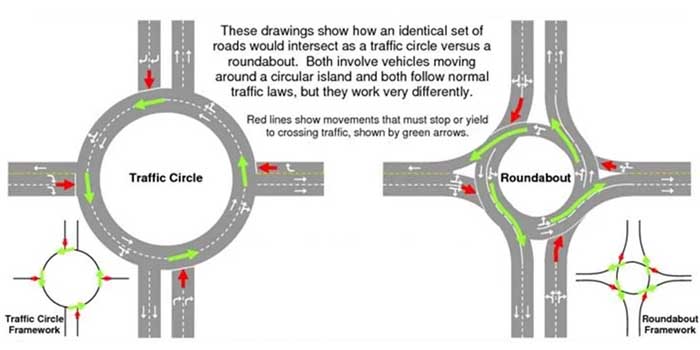
Size and Design
Roundabouts are mostly smaller and also have tight curves. These curves help you to slow down and drive your vehicles more safely. Plus, their design is simple & you will also see signs that tell you to give way before you enter.
On the other hand, traffic circles are large in size and have wider lanes. This structure allows you to drive fast. You will also find traffic signs & traffic lights around traffic circles. Its design is more confusing for you as compared to roundabouts.
Traffic Flow
When you are in a roundabout, you can keep moving your car as long as you don’t spot another vehicle coming from your left. Plus, you don’t need to stop every time. In such a way, you will see that traffic flows better and faster.
While in a traffic circle, you might have to stop even if you are already on a circle path. As a result, this affects the overall flow of traffic and it’s difficult for you to drive safely.
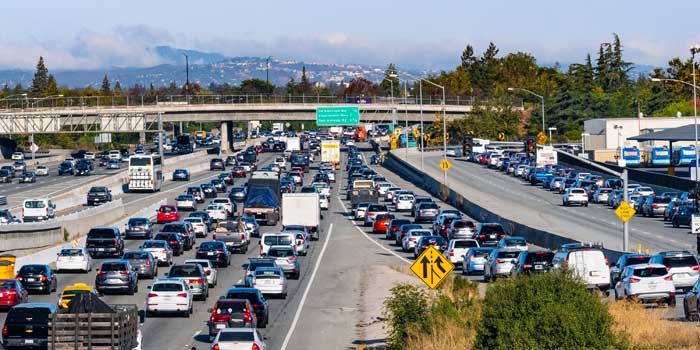
Speed Limits
You can drive your vehicle within the speed limit range of roundabouts, which is between 15 and 25 miles per hour (24 and 40 km/h). That actually means, you must drive slow. So that, you can easily avoid accidents.
For traffic circles, the speed limits are approximately 30 miles per hour (48 km/h) or more. This is a pretty fast speed which makes it hard for you to slow down quickly if needed.
Rules of Yield/Right of Way Rules
In roundabouts, you must yield to cars that are already moving. Further, you need to wait until you see the clear space to pass your car.
Rules of yield for traffic circles can be changed according to place & local traffic laws. For example; in some countries, if you are inside a circle, you may need to yield to cars joining the circle.
Use of Traffic Signs or Signals
You will observe yield signs while you drive in roundabouts. However, there is no placement of any traffic lights or other signs.
But, you may see stop signs plus traffic lights in traffic circles zones. That’s why you have to stop and wait (even if no cars are present).
Safety Features
Roundabouts are made with raised edges, clear lane markings and signs. Its center island design also provides safety for your large vehicles. You may also notice special paths for bikes and pedestrians which are mostly away from your car lane.
Traffic circles don’t always have that many safety properties. They may look more like normal roads with fewer signs & barriers. This structure makes it difficult for you to know where exactly you should drive.
Locations
You will find roundabouts in modern cities and busy roads. Because, in these areas, you need to manage traffic flow for smooth driving.
In contrast, traffic circles are generally built in older cities and historic areas. Also, you may see them where roads were built a long time ago.
Pedestrian Crossing
Roundabouts are safe for pedestrians, so they easily cross the road. This is because vehicles run on slow speed and you just need to watch other people who cross roads.
There are no paths for people who want to cross through a traffic circle. As cars come from many directions at a fast speed, it can be risky for you to walk in such situations.
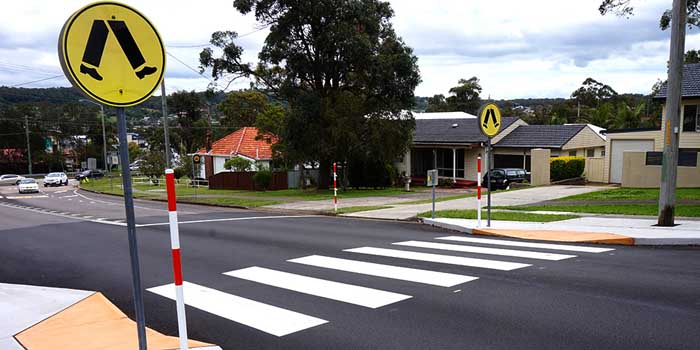
Lane Changing
Usually, you don’t need to change your lane once you pick your right lane before you enter the roundabout. Hence, you can safely drive without switching your lane inside the circle.
If you are inside a traffic circle, you may need to change your track. Because, other vehicles don’t follow one direction for riding. This makes it difficult for you to stay on one road line.
Entry Angle
There are gentle curves in roundabouts which help you to safely enter roundabouts. In such a way, you need to turn slowly and join the circle with a safe angle.
Traffic circles and roads are connected with each other at sharp angles. This leads to sudden moves and may cause dangerous accidents.
What is the Purpose of a Roundabout?
Improve Traffic Flow
The major aim of roundabouts is to reduce traffic jams and maintain the flow of vehicles. You don’t need to stop your car and wait for green lights to turn on. Rather than, you can keep driving your car at slow speed and go when the road is clear. This means more cars can move at the same time.
Reduce Crashes
As you need to drive your vehicles in slow speed and in one direction. This helps to reduce the chances of traffic crashes. Also, you will find no sharp turns and sudden stops. That means, you have pretty good control of your car and minimum risk of hitting another vehicle.
Lower Vehicle Speeds
Due to its curvy and circular infrastructure, you can’t drive your vehicles at a fast speed. Mostly, you can drive at 25 miles per hour or less. Hence, this speed provides you more time to notice other cars and people.
Increase Road Safety
When you drive slowly and follow one direction, it’s easier for you to avoid crashes. Plus, you don’t need to deal with ref lights & crossing traffic as well. So, the road will be safe and no danger for drivers, walkers & bike riders too.
Reduce Traffic Delays
As you know, roundabouts help you to keep moving your car without long stops. Unlike traffic lights, you don’t need to wait for a green signal. Because, you can slow your car, must look to your left and you can start driving your vehicle. In this way, you need to wait less, see shorter lines of cars and can pass fastly on busy roads.
Save Fuel & Lower Emissions
Your vehicle’s engine keeps running continuously which helps your car use less fuel. Thus, your car burns less gas. As a result, your car produces less smoke and pollution. This is beneficial for you and the environment too.
Safety of pedestrians & cyclists
Roundabouts also promote safety for people who walk or ride on their bikes. Because, cars move slowly, so you can easily cross the road without any danger. This helps both bikers and pedestrians stay safe on roads.
Eliminate Need For Traffic Signals
You have no need to install and maintain any types of traffic signals because roundabouts can work well without stop signs. The reason is that roundabouts’ circular design helps control traffic on their own.
Roundabout Rules
Regulations For Roundabout Lanes
As a responsible driver, you have to follow specific rules and legal requirements for roundabouts lanes.
-
- Single Lane Roundabout Rules: When you enter a single lane roundabout, you must slow down and wait for a safe space to cross. You should use your turn signal when you leave the lane and never try to stop around inside.
- Multi Lane Roundabout Rules: You have to choose your lance according to your exit point. For example: you can use the right lane if you want to turn your car in the right direction or move straight. However, you must follow the left lane, if you require to take a left exit turn.
Standards For Roundabouts Exit
Traffic authorities set clear roundabout exit rules on the basis of MUTCD traffic laws.
2 Exit Roundabout Rules: With 2 exits, you must use the left side if you want to take the first exit. Plus, you can choose the right side, if you want to drive straight.
3 Exit Roundabout Rules: For three exits, your lane’s priority depends on where you want to go. For your right turn & straight diving, you can use the same lane as you follow discipline in a 2-exit roundabout. But, when you enter the 3rd exit, you have to stay in the left lane & also on the left signal of the car.
4 Exit Roundabout Rules: In a 4-exit roundabout, you should drive on the right lane for the 1st or 2nd exit. You must use the left lane for the 3rd or 4th. Always remember to signal before you exit.
5 Exit Roundabout Rules: Generally, you need to drive on the right lane for 1st or 2nd exit. But for 4th & 5th, you should stay on the left lanes of roundabouts. Additionally, you must carefully see traffic signs for right directions.
What are the Features and Advantages of Roundabouts?
Following are some major benefits roundabouts:
- Your cars move in the same direction (one way movement) on roundabouts, which lowers the chance of crashes.
- Less stops helps emergency vehicles move through busy traffic faster.
- Pedestrians can easily cross roads due to the speed limit of vehicles.
- Mostly, drivers no need to stop and press the horn, which lowers the level of noise.
- When you enter, you need to slow down and this increases safety on intersections for everyone around you.
- As you don’t need to wait at red lights, which also saves your time and maintains the flow of traffic.
- Roundabouts can function without any electrical power.
- You may notice plants, flowers and arts in the center of roundabouts, which make the area more beautiful.
How Do Traffic Circles Work?
Basically, traffic circles are big and rounded intersections where you can drive your car around the center area. When you enter a traffic circle zone, you don’t need to slow down your vehicles. The reason is, they are generally bigger than roundabouts and may allow you to drive at fast speed.
Because, rules for traffic circles are not always clear. In contrast to roundabouts, if you are already inside this circle, you may need to stop for other cars that are entering the circle. Moreover, you will also see stop signs and traffic lights inside some traffic circles. So, when you drive inside traffic circles, you always need to notice and follow these signs carefully.
Who Has the Right of Way in a Roundabout?
- Emergency Vehicles: If you see an emergency automobile (police car/ambulance) with flash lights or siren, you should allow them to pass first.
- Inside Traffic: The cars that are already present inside the roundabout have the right of way. You need to slow down and wait to cross.
- Pedestrians: When you find people who walk across the streets, you must stop and let them go before you cross.
- Cyclist & Large Vehicles: As roadabouts are narrow, you should always give priority to cyclists and big vehicles, so they move first.
FAQs
How Do I Drive in a Single-Lane Roundabout?
In single lane roundabouts, you must reduce your car speed and look at your left side. If you notice enough gap to cross, you can keep moving in counterclockwise directions until you see your exit point.
Should I Stop Inside the Roundabout To Let Someone in?
You can’t stop your car inside the roundabouts. You must keep driving unless you observe any danger or road blockage ahead. In any case, if you stop inside a circle, it can lead to accidents and also confuse other drivers.
Do Roundabouts Work in Heavy Traffic?
Yes, roundabouts can work well if there is heavy traffic on roads. It helps you to drive without unnecessary stops. Also in busy times, it reduces traffic delay and your vehicle can move smoothly.
What is the Maximum Speed Limit on a Traffic Circle?
The speed limit for traffic circles basically varies based on where you are. So, you should check the signs installed around circles. However, we provide you with a general speed range which is around 30 miles per hour (48 km/h).
Conclusion
Finally, we hope you have now understood the comparison of roundabouts and traffic circles. You can see how their size, speed limit and rules are different. So, we can say that next time when you drive through them, you will know exactly what you need to do and what to expect.
More Helpful Readings:
What Round Signs Indicate? (or What Do Circle Signs Mean)
Safe Driving – Traffic Circles/Roundabouts | Purcellville, VA – Official Website


-80x69.png)

